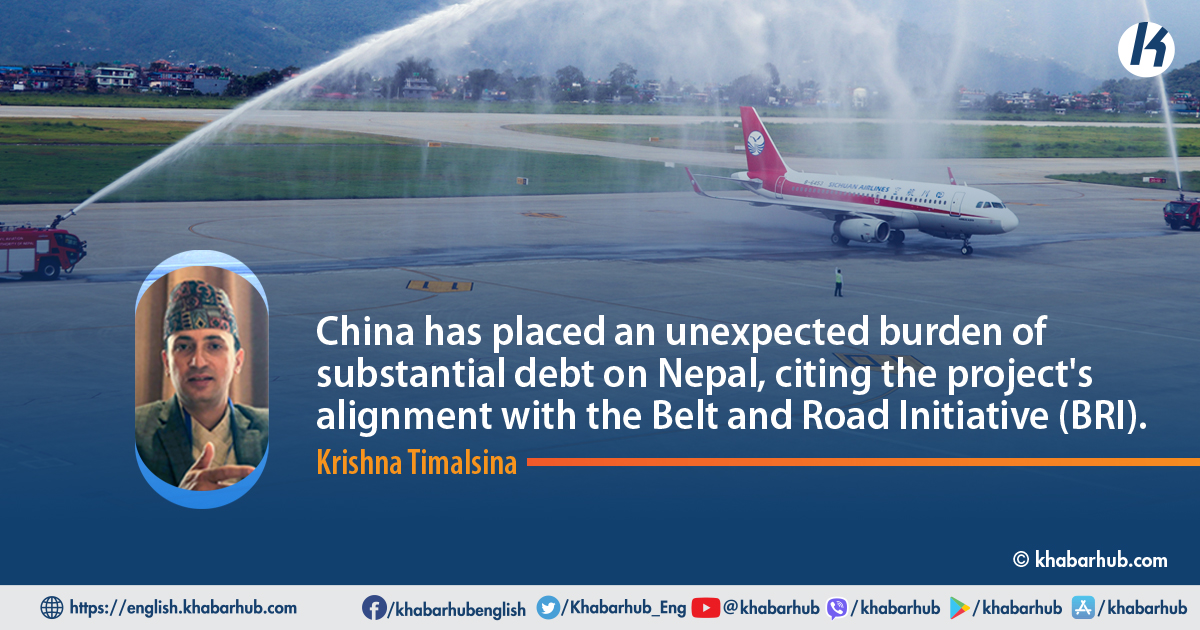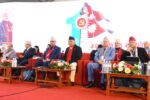China’s investment in Pokhara Regional International Airport has become a cause for concern as Nepal finds itself entangled in a complex financial situation.
Despite the initial investment agreement for the airport’s construction, China has unexpectedly burdened Nepal with substantial debt, citing the project’s association with the Belt and Road Initiative (BRI). Initially, it was conveyed that the airport was developed with a loan from China.
During a program held after the inaugural landing of the first international commercial flight at Pokhara International Airport, Chinese Ambassador to Nepal, Chen Song, made a statement claiming that the airport falls under China’s ambitious Belt and Road Initiative (BRI).
Surprisingly, no Nepali official present at the event, including Tourism Minister Sudan Kirati, immediately questioned the ambassador’s assertion.
Minister Kirati, instead of addressing the potential violation of the agreement’s terms, commended China and emphasized the deep friendship between Nepal and China, likening it to the towering height of Mount Everest.
During the inauguration ceremony of Pokhara Airport last December, the then Acting Ambassador, Wang Xin, dubbed the airport as a remarkable achievement for the BRI.
Meanwhile, experts had been advising the Nepalese government against accepting costly projects and loans associated with the BRI.
The Nepali authorities have explicitly stated that the construction agreement for the airport does not mention its association with the BRI.
According to Ratish Chandra Lal Suman, the former Director General of the Civil Aviation Authority, when the Chinese side proposed unfair conditions regarding the loan investment and interest recovery, the Civil Aviation Authority promptly rejected them.
The vision for constructing a regional international airport in Pokhara was initially proposed by the late King Birendra Shah in 1971. The architect behind this project was then Chief Shankarraj Pathak.
Subsequently, a loan investment agreement was signed with the Chinese Exim Bank in May 2014. It is important to note that the term “BRI” was not mentioned anywhere in this agreement.
Suman, who served as the Director General of the Civil Aviation Authority at that time, recollects signing a preliminary agreement stating that this project of national importance would be constructed with the assistance of a loan from China’s Exim Bank.
However, the agreement only specified that the Exim Bank would invest 20 percent of the loan for the airport’s construction over a 20-year period.
The Chinese bank has ensnared Nepal by imposing a hefty two percent interest rate on the substantial loan investment.
Furthermore, China has now created another predicament by claiming that the airport falls under the Belt and Road Initiative (BRI), contrary to the existing agreement.
Experts assert that the airport was not constructed as part of the BRI project, and Nepal did not include it in the investment agreement or the project selection and priority list under the BRI.
In violation of the project agreement, China has imposed exorbitant interest rates and unusual loan conditions, burdening Nepal with debt once the airport was completed, all while asserting its inclusion in the BRI.
Ambassador Chen Song repeatedly emphasized that the Chinese government had provided assistance in the design and construction of Pokhara International Airport.
Pokhara International Airport, designed and constructed with the support of the Chinese government, commenced operations in January 2023.
Despite the ambassador’s persistent references to the expensive loans associated with the BRI, Minister Kirati, who was present at the event, praised China.
To finance the construction of the international airport in Pokhara, the Nepalese authority secured a loan of 1.378 billion Chinese yuan from the Chinese government and Exim Bank through the government of Nepal in 2072.
The loan agreement consisted of 355.59 million 30 thousand yuan without interest and 1.28 billion 28 million 10 thousand yuan with interest payment conditions.
As per the agreement, Exim Bank provided a grace period of 7 years, allowing a trial period, which ended three months ago.
Nepal is now approaching the deadline to make the first installment payment of the loan to China within the next three months.
The loan agreement stipulates that both the principal and interest must be repaid within the following 13 years.
However, the airport has not generated sufficient income as expected. Despite the notion of Chinese investment and technology, no international airline companies have expressed interest in operating flights to Pokhara.
Considering that Pokhara serves as a crucial destination for Indian tourists, as it is a gateway to Muktinath, the lack of direct flights from Indian airlines can be attributed to the perception surrounding Chinese investment and technology.
Amidst the confusion and uncertainty surrounding the repayment of the loan, China sent a group of Chinese players directly to Pokhara via a charter flight operated by Sichuan Air.
It was concluded that a large-scale investment in Pokhara in a single phase would not be economically feasible. The first phase, recommended to be completed between 1995 and 2000, required an estimated expenditure of $40 million.
However, it remains uncertain whether regular Chinese flights will operate to Pokhara beyond charter services.
Despite the Chinese side’s initial claim that the airport would connect various cities in China through air services, no Chinese airline has shown interest in establishing regular flights to Pokhara, even after almost a year since the airport’s inauguration.
Moreover, China’s labeling of the investment as part of the Belt and Road Initiative (BRI) during the landing of the first Chinese plane at Pokhara Airport further highlights its debt trap strategy.
It is worth noting that the operational expenses of the large airport are covered by the revenue generated from the smaller the then Airport.
How did the control of Pokhara Airport end up in Chinese hands?
After the inauguration of Pokhara’s regional international airport on January 1, 2023, Sichuan Air operated the first direct charter flight from China last Wednesday.
However, prior to this, the airport remained inactive for four months, and unfortunately, it continues to face the same fate.
The establishment of the Regional International Airport in Pokhara was a result of the five-decade-long aspirations and struggles of the local population. However, the airport has faced significant financial challenges that have hindered its operations.
Following the withdrawal of support from the Asian Development Bank (ADB), the extensive studies conducted by JICA and the land acquisition efforts, faced a halt.
The vision for constructing a regional international airport in Pokhara was initially proposed by the late King Birendra Shah in 1971. The architect behind this project was then Chief Shankarraj Pathak.
In accordance with King Birendra’s vision, the government entrusted the German engineering firm DIW in 1971 to carry out site selection and detailed engineering for the airport.
The process of land acquisition for Pokhara Airport began in 1976, after the completion of preliminary studies and the formulation of plans for the new regional airport.
During the land acquisition phase, the government initiated further studies based on a preliminary report prepared by DIW.
In 2045 BS, the Master Plan was reviewed, and the Japan International Cooperation Agency (JICA) recommended that the airport be built in two phases.
It was concluded that large-scale investment in Pokhara in a single phase would not be economically feasible. The first phase, recommended to be completed between 1995 and 2000, required an estimated expenditure of $40 million.
Similarly, the second phase was planned for the period of 2001 to 2010, with an estimated cost of $45 million. A proposal was made to secure a maximum of $85 million from the Asian Development Bank (ADB) to complete both phases of the project.
China’s Exim Bank then entered the scene with the support of a faction of the Maoists. Exim Bank stipulated that only certain companies on their list would be allowed to bid for the contract, threatening to withhold loan investments otherwise.
However, the ADB withdrew its support after the government pledged to proceed with both phases as a single project.
Following the withdrawal of support from the Asian Development Bank (ADB), the extensive studies conducted by JICA and the land acquisition efforts, faced a halt.
Donors were hesitant to make large loan investments considering the economic activities in Pokhara. In the midst of this crisis, the Chinese state-owned contractor CAMCE entered the picture.
After the political movement in 2063, the significance of Pokhara Airport gained renewed attention. A recent air agreement was signed between Nepal and India to facilitate commercial flights to various Indian cities.
However, during the implementation of the agreement, the government changed, with three Prime Ministers taking office.
Eventually, the government led by Dr. Baburam Bhattarai, with Barshaman Pun as the Finance Minister, declared the airport as a project of national pride.
The process of determining who would build the airport in Pokhara, how, and when became a subject of debate.
However, without engaging in public discourse on resource mobilization, Finance Minister Pun signed an agreement with the Chinese engineering company CAMCE.
This move raised concerns about transparency and fairness. Eventually, following an investigation by the authority, the non-transparent Memorandum of Understanding (MoU) signed on September 20, 2011, was canceled.
The government decided not to award the airport construction work to CAMCE without a competitive process.
Those who raised questions about this issue were labeled as anti-development and faced persecution. According to Pokharel, it was unclear under what terms and conditions the loan would be invested, and Nepal entrusted the project directly to the Chinese contractor under political influence, leading to a trap for Nepal.
The people of Pokhara expressed their frustration by going on a hunger strike for 100 days, highlighting their discontent with the lack of progress in the airport construction despite the land acquisition process spanning over 35 years.
Subsequently, on July 18, 2012, the Civil Aviation Authority issued an international call for tenders for the construction of the airport.
During this period, the Asian Development Bank withdrew its involvement, citing financial inviability of the airport project.
China’s Exim Bank then entered the scene with the support of a faction of the Maoists. Exim Bank stipulated that only certain companies on their list would be allowed to bid for the contract, threatening to withhold loan investments otherwise.
As a result, out of the initial 22 interested companies, only 9 submitted their forms after Exim Bank’s notification.
Additionally, 6 companies were not on Exim Bank’s list. Consequently, although 22 companies had initially expressed interest, only 3 Chinese companies were selected to compete in the tender process according to Exim Bank’s strategy.
Among them, CAMCE submitted the lowest bid of $305 million, followed by Sino Hydro with bids worth $337.82 million, and another Chinese company with a bid of $349.28 million.
These bids were considerably higher than expected. However, due to the assurance of loan assistance from China’s Exim Bank, the increased investment amount did not face significant scrutiny.
Experts argue that based on this agreement, the construction cost of the airport exceeded $700 million. Due to the overwhelming debt burden, the Civil Aviation Authority refused to sign the loan agreement as per the conditions imposed by Exim Bank, leading to employee strikes.
The then Vice President of the National Planning Commission, Jagdish Chandra Pokharel, recollects that the construction of Pokhara airport was carried out in a non-transparent manner, resulting in a cost increase of $70 million compared to the previous design.
Those who raised questions about this issue were labeled as anti-development and faced persecution. According to Pokharel, it was unclear under what terms and conditions the loan would be invested, and Nepal entrusted the project directly to the Chinese contractor under political influence, leading to a trap for Nepal.
During that time, it was almost certain that the highly expensive contract for Pokhara airport would be awarded to the Chinese company CAMCE.
Experts at the time raised concerns about the lack of transparency in the investment process.
When the Nepal government prepared a detailed project report for the airport construction with the assistance of the Asian Development Bank, the proposed cost of $305 million was 80 percent higher than the lowest bid received for the project.
Vice President Dr. Pokharel asserts that the total cost of the airport will reach $132 million, and the proposal put forth by the Chinese company is excessively expensive.
Initially, the Chinese company claimed that the airport could be built for $264 million, but during the tender process, the amount increased to $305 million. This represents an increase of approximately $75 to $80 million in investment.
Continuing with the non-transparent decision-making process, in April 2014, the government officially decided to acquire a $217 million loan from China’s Exim Bank and awarded the construction of the airport to a Chinese company.
Domestic airlines continue to operate from the old airport rather than the new one, and no new national or international flight destinations have been added. The Pokhara Airport has become a debt trap, tightening its grip on a small economy like Nepal on a daily basis.
Maoist leader Barshman Pun acted as an official representative for the Chinese side in this matter. Subsequently, in 2016, an initial agreement was signed with the Chinese company CAMCE Engineering to construct the airport at a cost of $215.96 million.
Experts argue that based on this agreement, the construction cost of the airport exceeded $700 million. Due to the overwhelming debt burden, the Civil Aviation Authority refused to sign the loan agreement as per the conditions imposed by Exim Bank, leading to employee strikes.
The former Director General of the Civil Aviation Authority, Ratish Chandralal Suman, explains that he rejected the condition set by Exim Bank, which required the Civil Aviation Authority to open a joint account to pool all the revenues from its various airports for the repayment of the loan principal and interest.
It was not feasible to solely rely on the income from Pokhara Airport to repay the loan investment. This understanding was reached by the Chinese side as well.
With the condition of opening a joint account solely for the income of Pokhara Airport, from which the principal and interest would be paid,
Director General Suman finally signed the initial agreement under the government led by Sushil Koirala. The agreement specified that China’s Exim Bank would provide a loan at a two percent interest rate for the construction of the airport, with no mention of the Belt and Road Initiative (BRI).
In 2016, after the formation of the KP Sharma Oli-led government in Nepal, Prime Minister Oli visited China. In Beijing, a soft loan agreement of $215.96 million was signed, where Exim Bank would deduct 25 percent of the amount as interest and only invest 75 percent of the loan.
This agreement retained the condition of the high foreign loan interest rate of two percent annually, which the Pokhara Airport had to repay within 20 years.
However, geo-political affairs expert Arun Kumar Subedi argues that even within 100 years, the Pokhara Airport will struggle to repay China’s debt.
This poses a significant challenge, as in the next three months, Exim Bank China will require a monthly interest payment of 3.2 million dollars, adding further pressure and burden on the airport’s finances.
He suggests that the operation of the airport should be entrusted to China, stating that the loan agreement has become a mixture of opaque interests and conditions.
The foundation stone of the Pokhara Regional International Airport was laid by Prime Minister KP Oli on April 13, 2016, after Exim Bank confirmed its investment.
Following the completion of the remaining procedures, the Chinese contractor company CAMCE began construction on November 1, 2017.
Despite its inauguration on January 1, 2023, by Prime Minister Pushpa Kamal Dahal ‘Prachanda’, the airport remains deserted.
Domestic airlines continue to operate from the old airport rather than the new one, and no new national or international flight destinations have been added. The Pokhara Airport has become a debt trap, tightening its grip on a small economy like Nepal on a daily basis.
Last year, Pokhara Airport generated a revenue of 11.59 million rupees, but since its operation began, expenses have only increased. The earnings are disappointing, and the airport is struggling to meet its financial obligations.
To cover the expenses incurred in the construction of the airport and its capital interest, the new airport alone needs to earn 11.4 million dollars or 1 trillion 50 billion rupees annually.
However, due to the closure of most flights and landings from the old airport and the consolidation of income from both airports into one account, the monthly income has decreased significantly, approximately 13 times less than the average.
This poses a significant challenge, as in the next three months, Exim Bank China will require a monthly interest payment of 3.2 million dollars, adding further pressure and burden on the airport’s finances.








Comment